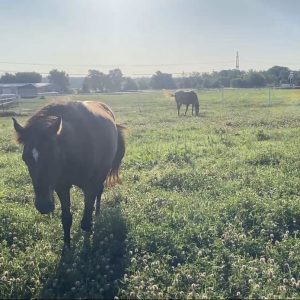This summer, I’ve been trimming Chewie’s feet approximately every two weeks.
Frequent trimming makes the task quicker and easier for both of us. It also lets me watch how her hooves are growing.
About a month ago, Chewie sustained a mild injury in the pasture. We aren’t sure what happened. Luckily, it was not anything serious. But, it’s been really interesting to watch how her hooves have responded.
After the injury, Chewie had a handful of superficial scrapes on her back right leg (no blood) and a little swelling for a couple of days. She never took a lame step or seemed bothered by the injury.
However, when I trimmed her feet about ten days after the injury, I noticed a difference in her back feet. Her back right hoof was just a little longer than the left.
Chewie’s hoof wear patterns told me that she had been using her back legs slightly differently. My guess is that she was putting slightly more weight on the uninjured leg both when moving and resting.
I trimmed Chewie’s back feet again today, two weeks after the last trim. I was able to notice a very small difference between her back two feet. If I hadn’t been looking really closely, I probably would not have noticed.
She may still be using the injured leg slightly differently than her other leg. Or, she may have been doing so in the days right after the last trim.
Sometimes, our animals may be in pain or discomfort in small ways. I can think of times in the past when I’ve had a small injury that bothered me a little bit and probably changed the way I moved, even though it wasn’t enough to alter my regular routines.
As an animal trainer, I’m constantly paying attention to Chewie’s behavior, both during our training sessions and during our informal interactions.
However, I can also learn a lot by constantly paying attention to her physical appearance, including her hoof health, muscle development, weight, and more.
Having a good sense of what is normal can help us notice when an animal’s body or behavior starts to change, even if these changes are subtle. Then, we can use this information to make better decisions related to our animals’ care and training.
What have you observed recently when you’ve looked closely at your animals?


No comments yet.